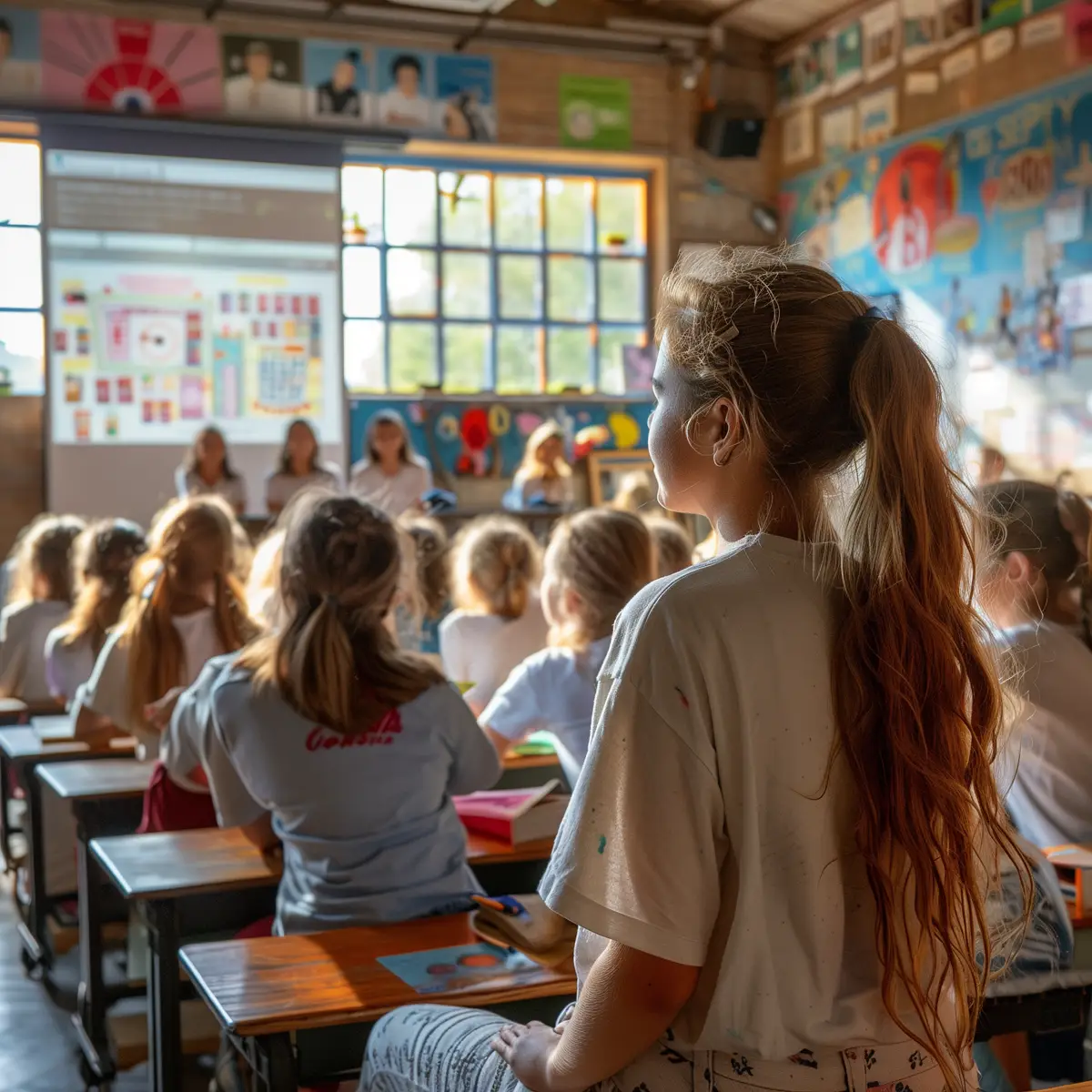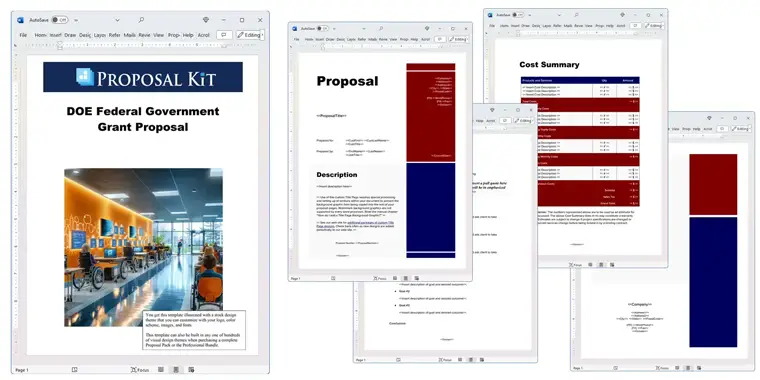How to write your DOE Federal Government Grant Proposal
We include this 23 page layout with every Proposal Pack. If you want this template to have a different visual design theme than the one illustrated here, purchase any Proposal Pack design and create this template using the purchased design theme. This template is included in every Proposal Pack. If you get a Proposal Pack or the Professional, you can also make any variation of this template with different chapters to suit your needs.
We typically include more chapters in the templates than most people will need to give everyone more variety in the chapters they may need. You can trim down a long template by removing pages you do not need or combining multiple chapter topics into one page.
 DOWNLOADABLE, ONE-TIME COST, NO SUBSCRIPTION FEES
DOWNLOADABLE, ONE-TIME COST, NO SUBSCRIPTION FEES![]() View DOE Federal Government Grant Proposal
View DOE Federal Government Grant Proposal
This sample proposal is based on the same layout as this template and is included in every Proposal Pack. The visual design of the templates will match whichever Proposal Pack design you purchase. To get this template in a different design theme than shown in the sample, purchase any other Proposal Pack design theme and this template will be included.
You can create an editable Word version of this sample in any design theme of your choice including branded to your logo.
You can also create countless variations of this document to suit your needs using the included library of 2200+ chapters if ordering a Proposal Pack or Professional.
 What Our Clients Say
What Our Clients SayI found Proposal Kit a little over two years ago when I needed to create a very extensive proposal for a project. I struggled with integration of Proposal Kit into my word processor, however, I was able to manage to use the sample proposal content and to incorporate it into my proposal. I was able to create an amazing proposal that I felt very confident about."
Related Article
Related Video
Related Templates
- DOE Federal Government Grant Proposal #2
- Educational Grant Proposal #2
- Grant Proposal for Special Needs Support
- Daycare Preschool Grant Funding Proposal
- STEM Educational Program Proposal
- Orphanage Non-Profit Funding Support Proposal
- Educational Grant Proposal
- Non-Profit Parenting Distance Learning and Workshop Proposal
- Computer Lab for Students Educational Proposal
- Distance Learning Education Proposal
- Science Lab for Students Educational Proposal
- HHS Federal Government Grant Proposal 2
- School Improvement Project Proposal
- Educational Training for Special Needs Proposal
- EPA Federal Government Grant Proposal 2
- School Funding Request Proposal
- DOJ Federal Government Grant Proposal
- DOE Federal Government Grant Proposal 2
- HHS Federal Government Grant Proposal
- DOJ Federal Government Grant Proposal 2
- Defense Contracting Intelligence System Proposal
- EPA Federal Government Grant Proposal
- Educational Grant Proposal 2
- DOH Federal Government Grant Proposal
- USDA Federal Government Grant Proposal
What's the Best Way to Write Your DOE Federal Government Grant Proposal?
Securing a Department of Education (DOE) federal government grant is pivotal for many educational initiatives. Still, the process can be complex and intimidating, especially for those with extensive proposal writing experience. The solution? Using the Proposal Kit template and software package. This powerful tool simplifies the creation of a detailed and persuasive DOE federal government grant proposal, incorporating essential elements such as cost summaries, quotes, estimates, budgets, and other financial details with its line item quoting database system.
The Proposal Kit includes many templates for responding to federal RFPs and an additional instruction manual on creating proposals responding to federal grant RFPs.
Are you faced with writing a DOE federal government grant proposal and need help determining where to begin? Proposal Kit is designed to guide you through this process, providing the structure and resources required to write a compelling proposal.
What Types of Projects Are DOE Federal Government Grant Proposals Written For?
Regarding DOE federal government grants, the projects can vary widely, each addressing unique needs within the educational sector. RFPs are issued by the Department of Education every year, and each one is unique, requiring a uniquely written RFP response. The Proposal Kit can assemble any complex RFP response document to match an RFP's requirements. This template is just one example. Examples include:
- Development of STEM (Science, Technology, Engineering, Mathematics) curriculum materials.
- Implementation of after-school tutoring programs for at-risk students.
- Launching innovative distance learning programs.
- Upgrading classroom technology and infrastructure.
- Researching educational outcomes and teaching methodologies.
- Initiating teacher training and professional development programs.
- Establishing community education and adult learning centers.
- Creating educational apps and digital learning tools.
- Promoting literacy and reading programs in underserved communities.
- Supporting special education programs and services for students with disabilities.
Chapters this template is built with
Proposal Kit's extensive template library offers a structured approach to proposal writing, covering all the critical elements of a successful DOE federal government grant proposal. This is just one example of a set of topics used to respond to a specific federal grant.
By expanding on these essential components with clarity and depth, your DOE federal government grant proposal will not only meet the stringent requirements of the application process. Still, it will stand out for its comprehensiveness, coherence, and compelling vision. Proposal Kit provides the structure and guidance to ensure each proposal section is written precisely, making it an invaluable resource in your quest for federal funding.
This selection from Proposal Kit's template library covers only a fraction of the resources available to customize your DOE federal government grant proposal, ensuring you can address all necessary topics and requirements.
Cover Sheet
The cover sheet is the gateway to your proposal, offering a snapshot of essential details. It should present your organization's name, the project title, contact information, and the specific DOE grant you're applying for. This is where you make your first impression, setting a professional tone for the review process.
Abstract
The abstract is your project's elevator pitch. In no more than a few hundred words, it must convey the essence of your initiative - its objectives, significance, and the positive change it aims to bring about. This concise summary should captivate and intrigue, encouraging further exploration of your proposal.
Needs Assessment
In the needs assessment, you lay the groundwork by articulating the educational gaps your project intends to fill. Utilize current statistics, research findings, and possibly testimonies to paint a vivid picture of the need for your project. This section should resonate with urgency, compelling the reader to recognize the importance of your proposed solution.
Significance
This section delves into the transformative potential of your project. Discuss how it will innovate educational practices, enhance student learning outcomes, and positively affect the community. Highlighting the broader implications of your initiative, the significance section frames your project as beneficial and essential.
Project Methods
Here, you outline the how of your project. Describe the strategies, technologies, and pedagogical approaches you will employ to achieve your goals. This section should convey a clear, logical plan of action, demonstrating that your methods are theoretically sound and practically achievable.
Activities and Design
Detail your project's specific activities, from instructional sessions to community outreach efforts. Explain how these activities are designed to work synergistically towards meeting your project's objectives. This narrative should clarify that every aspect of your program has been thoughtfully considered and contributes to a cohesive whole.
Project Background
Provide a narrative of your organization's journey and any relevant experience that underscores your ability to execute the proposed project successfully. Mention previous initiatives, achievements, and lessons learned, establishing a track record that builds confidence in your proposal.
Project Management
Illustrate the organizational structure that will oversee the project's implementation. Name the key personnel and their roles and responsibilities, emphasizing their expertise and commitment to the project's success. This section reassures the DOE that your project is in capable hands.
Time Line
Present a detailed timeline with milestones and deadlines from inception to completion. This schedule should be realistic, considering the scope of the project and any external dependencies. A well-planned timeline demonstrates your project management understanding and commitment to timely delivery.
Resources
Catalog the resources necessary for your project, categorizing them into human, material, and technological. Justify the need for each, explaining how they are critical to the project's success. This thorough accounting shows prudent planning and foresight.
Evaluation
Detail your evaluation plan, specifying the metrics, methodologies, and frequency of assessments. This section should outline a robust framework for measuring project efficacy, demonstrating your commitment to accountability and continuous improvement.
Credentials and Resume
Incorporate the resumes or credentials of principal project members, showcasing their qualifications, experiences, and achievements. This section provides tangible evidence of your team's ability to deliver on the project's promises.
Partnerships
Describe any strategic partnerships or collaborations, detailing how they will augment the project's reach and impact. Letters of support or MOUs (Memoranda of Understanding) can bolster this section, evidencing a collaborative spirit and community endorsement.
Policies
Outline the policies guiding your project, ensuring they align with DOE standards and ethical considerations. This demonstrates your commitment to integrity, compliance, and best practices in education.
Benchmark Results
If your project is based on a pilot or previous initiative, share those results as evidence of feasibility and potential success. This empirical data can significantly strengthen your case, showing that your project has a solid foundation.
Commitment and Collaboration Letters
Include letters of commitment and collaboration from key stakeholders, partners, and community leaders. These letters serve as endorsements, showcasing broad-based support and confidence in your project's value and viability.
Worksheet
Supplement your proposal with detailed worksheets or appendices containing additional data, budget breakdowns, and supplementary information. This level of detail demonstrates thorough planning and transparency, which are critical components of a trustworthy proposal.
Use cases for this template
Tyler's Educational Innovation Expanded
Tyler, the forward-thinking owner of an educational technology company, recognized the transformative potential of integrating virtual reality (VR) into STEM education. His vision was clear: to create immersive, interactive learning experiences that would engage students in unprecedented ways, making complex concepts accessible and captivating. However, bringing this vision to life required substantial funding and resources, prompting Tyler to target a highly competitive Department of Education (DOE) grant.
The challenge was formidable. Tyler needed to convincingly articulate his VR project's innovation, effectiveness, and necessity in a landscape crowded with high-caliber proposals. That's where Proposal Kit came into play. Leveraging its comprehensive suite of templates and resources, Tyler meticulously wrote each section of his proposal, from the cover sheet to the detailed budget, with precision and clarity.
The Proposal Kit guided him through structuring his argument and helped him highlight the project's groundbreaking approach to STEM education. Tyler presented a compelling case for how VR could revolutionize the classroom, offering unparalleled opportunities for experiential learning, engagement, and retention of complex material.
The result? Tyler's proposal stood out for its innovation, depth, and feasibility, winning the DOE grant and securing the necessary funding to bring his visionary project to life. This success marked a significant milestone for his company and STEM education, paving the way for future advancements in immersive learning technologies.
Emma's Swift Submission Expanded
Emma was in a high-pressure situation that many professionals dread: a looming deadline for a crucial DOE federal government grant proposal. Educational Futures Inc., her employer, had set its sights on securing funding for a literacy initiative that promised to impact underserved communities significantly. With the clock ticking, traditional proposal writing methods were off the table.
Emma searched for efficiency without sacrificing quality and turned to the Proposal Kit. The decision was a game-changer. Proposal Kit's structured templates provided a clear pathway through the proposal's complexities, ensuring no essential element was overlooked. To maximize her productivity, Emma complemented the Proposal Kit with an AI writing tool, which generated initial drafts based on strategic prompts she provided.
This innovative approach allowed Emma to assemble a comprehensive, coherent, and compelling proposal within a tight timeframe. She adeptly blended AI-generated content with the meticulous detail and customization of Proposal Kit templates, writing a document that met and exceeded her superiors' expectations.
Emma's swift submission not only met the deadline but did so with a proposal that compellingly communicated the literacy initiative's potential impact. The grant's successful acquisition underscored her approach's efficacy, leveraging technology to enhance productivity without compromising the proposal's quality or persuasive power.
Alex's Global Initiative Expanded
Alex, at the helm of Global Learning Non-Profit, was driven by a mission to expand educational access on a global scale. The opportunity presented by a DOE grant to support international education initiatives seemed tailor-made for his organization's goals. However, responding to such an RFP required a proposal that not only detailed the non-profit's vision but did so in a way that was both comprehensive and persuasive.
Facing the task of articulating a complex, multi-national project, Alex turned to Proposal Kit for guidance. With its array of templates and resources, Proposal Kit enabled Alex to systematically address each requirement of the RFP, from outlining the project's scope and objectives to detailing the implementation strategy and anticipated impact.
Through the Proposal Kit, Alex effectively conveyed how the non-profit would leverage the grant to build and expand educational programs across diverse geographical locations. He highlighted partnerships with local organizations, innovative teaching methodologies tailored to different cultures, and technology to bridge academic gaps.
The proposal written with the help of the Proposal Kit captured the spirit of Alex's global initiative and demonstrated the project's feasibility and potential for significant impact. Winning the DOE grant was a testament to the power of a well-written proposal, enabling Global Learning Non-Profit to embark on its mission to bring education to corners of the globe where it was most needed.
Conclusions and Recommendations
By providing a structured, thorough approach to proposal writing, Proposal Kit ensures that individuals and organizations can effectively communicate their vision and secure the funding necessary for their educational projects. The answer is clear for anyone looking to write a DOE federal government grant proposal: starting with Proposal Kit sets you on the path to success, making it the best way to achieve your grant writing goals.
Also Known As
This template may also be referred to in different ways or be used in more specialized situations, such as:
- DOE Grant Application
- Department of Energy Funding Proposal
- DOE Project Submission
- Federal Energy Grant Request
- DOE Grant Funding Application
- Energy Department Grant Proposal
- DOE Financial Assistance Application
- Federal DOE Project Plan
- DOE Grant Submission
- DOE Funding Request Document
Abstract
 Navigating the process of securing a federal government grant, particularly from federal agencies like the Department of Energy (DOE), can be daunting for prospective grant applicants. However, the Proposal Kit emerges as an invaluable resource, simplifying the task with its comprehensive proposal toolkit. It assists applicants in creating precise DOE grant proposals by incorporating important topics such as budgeting and technical assistance. Catering to a variety of project types, from renewable energy initiatives to energy efficiency improvements, the Proposal Kit is a vital ally in meeting the unique criteria set by federal grant-making agencies.
Navigating the process of securing a federal government grant, particularly from federal agencies like the Department of Energy (DOE), can be daunting for prospective grant applicants. However, the Proposal Kit emerges as an invaluable resource, simplifying the task with its comprehensive proposal toolkit. It assists applicants in creating precise DOE grant proposals by incorporating important topics such as budgeting and technical assistance. Catering to a variety of project types, from renewable energy initiatives to energy efficiency improvements, the Proposal Kit is a vital ally in meeting the unique criteria set by federal grant-making agencies.
The Proposal Kit provides templates are specifically designed to align with funding opportunity announcements (FOAs) issued by government agencies. These templates cater to projects spanning fundamental scientific research in the physical sciences to small business innovation research. As federal agencies release FOAs, eligible institutions such as universities and small businesses can develop proposals that highlight projects' significance, methods, and expected outcomes. The Proposal Kit ensures that each section of the proposal, from the cover sheet to the credentials and resumes of key personnel, is addressed comprehensively.
Additionally, the Proposal Kit supports proposals involving collaborations with DOE's national laboratories, offering a structure for detailing partnerships and the utilization of DOE's office resources. By using this proposal toolkit, applicants can ensure their submissions are aligned with DOE's standards, demonstrating a thorough understanding of merit review requirements and funding opportunities. Through a well-organized management system and precise project timeline, the Proposal Kit helps illustrate a project's feasibility and potential impact, ultimately enhancing the likelihood of a competitively awarded grant or contract. For a more thorough understanding of how to navigate these funding opportunities, applicants are encouraged to contact us for details and explore the extensive range of resources developed to facilitate successful DOE grant submissions.
 The Proposal Kit offers a structured approach for individuals and institutions aiming to secure a DOE federal government grant. This resource is particularly beneficial for prospective grant applicants who must navigate the intricacies of funding opportunity announcements (FOAs) from federal grant-making agencies. By providing detailed guidance on creating a proposal, the Proposal Kit supports projects in areas such as renewable energy, energy efficiency, and fundamental scientific research. These areas are often prioritized by the DOE's Office of Science and other government agencies focused on advancing innovations within the physical sciences.
The Proposal Kit offers a structured approach for individuals and institutions aiming to secure a DOE federal government grant. This resource is particularly beneficial for prospective grant applicants who must navigate the intricacies of funding opportunity announcements (FOAs) from federal grant-making agencies. By providing detailed guidance on creating a proposal, the Proposal Kit supports projects in areas such as renewable energy, energy efficiency, and fundamental scientific research. These areas are often prioritized by the DOE's Office of Science and other government agencies focused on advancing innovations within the physical sciences.
The Proposal Kit is designed to aid applicants, including universities and small businesses, in developing proposals that address specific FOAs. These proposals can range from small business innovation research projects to initiatives at DOE's national laboratories. The Proposal Kit also emphasizes the importance of presenting a clear project management system and evaluation plan, ensuring that proposals not only meet but exceed the merit review criteria set by funding agencies.
In addition to templates, the Proposal Kit provides technical assistance and a robust database system for cost summaries and budget justifications. This feature helps applicants accurately outline the financial topics of their projects, reinforcing their credibility and preparedness. Moreover, the Proposal Kit offers insights into formula grants and the DOE office's expectations, guiding applicants through the intricacies of the application process.
 For researchers and institutions aiming for higher education funding, the Proposal Kit serves as a comprehensive resource that enhances proposal quality and coherence. By detailing the project's significance, methods, and anticipated outcomes, applicants can convey their initiative's potential impact. The Proposal Kit also includes resources for illustrating partnerships with national laboratories and other stakeholders, fostering a collaborative spirit important for successful project implementation.
For researchers and institutions aiming for higher education funding, the Proposal Kit serves as a comprehensive resource that enhances proposal quality and coherence. By detailing the project's significance, methods, and anticipated outcomes, applicants can convey their initiative's potential impact. The Proposal Kit also includes resources for illustrating partnerships with national laboratories and other stakeholders, fostering a collaborative spirit important for successful project implementation.
Ultimately, the Proposal Kit is an important tool for anyone seeking to develop a persuasive DOE grant proposal. Applicants can access a wealth of resources tailored to meet the rigorous demands of federal funding opportunities, paving the way for successful grant applications and impactful research endeavors.
Frequently Asked Questions
What are the essential components of a DOE Federal Government Grant RFP response?
A comprehensive DOE RFP response should include a cover letter, executive summary, technical proposal, budget justification, and supporting documents. The technical proposal should detail the project objectives, methods, timeline, and expected outcomes, while the budget justification must clearly explain the financial needs and allocation of funds. Supporting documents may include resumes of key personnel, letters of commitment from partners, and any required certifications.
How can I ensure my response aligns with the DOE's priorities and evaluation criteria?
To align your response with the DOE's priorities, thoroughly review the RFP to understand the specific goals and evaluation criteria. Highlight how your project addresses these priorities and use relevant data to demonstrate the need and potential impact. Tailor your objectives, methods, and outcomes to closely match the DOE's goals and ensure you meet all eligibility and formatting requirements.
What are the common mistakes to avoid when writing a DOE grant RFP response?
Common mistakes include missing submission deadlines, failing to address all RFP requirements, providing vague or unsupported claims, and submitting a disorganized or poorly formatted proposal. Avoid jargon and overly technical language, ensure your budget is realistic and well-justified, and double-check that all required documents and certifications are included. Thoroughly review the RFP and your response to avoid any overlooked details.
How do I effectively demonstrate my project's feasibility and potential impact?
Provide a detailed project plan with clear, measurable objectives and a realistic timeline to demonstrate feasibility and impact. Include data and evidence to support the need for your project and its expected benefits. Highlight the expertise and experience of your team, describe any pilot studies or preliminary results, and outline a robust evaluation plan to measure the project's success. Show strong stakeholder support through letters of commitment and partnerships.
What strategies can I use to make my DOE RFP response stand out?
To make your response stand out, ensure it is clear, concise, and well-organized. Use headings, bullet points, and visuals like charts and graphs to enhance readability. Emphasize the innovative aspects of your project and how it addresses a critical need. Provide compelling evidence of your project's potential impact and sustainability. Tailor your language and content to align with the DOE's mission and priorities, demonstrating a deep understanding of their goals.
20% Off Discount
![]() Add To Cart This Word Template
Add To Cart This Word Template
 Add To Cart Proposal Pack for Government Grants
Add To Cart Proposal Pack for Government Grants
 Add To Cart Proposal Kit Professional
Add To Cart Proposal Kit Professional
 4.7 stars, based on 849 reviews
4.7 stars, based on 849 reviewsProposal Kit chapters used in this template
Cover Sheet, Title Page, Table of Contents, Abstract, Needs Assessment, Significance, Project Methods, Activities, Design, Project Background, Project Management, Time Line, Resources, Evaluation, Credentials, Resume, Partnerships, Policies, Benchmark Results, Commitment Letters, Collaboration Letters, Worksheet, Back Page
Line Item Automated Chapters
If you purchase a Proposal Pack or the Professional Bundle, these proposal pages are generated using an automated line-item database in the included Wizard software.
Time Line
You use this proposal for
- Non-technical proposal
- Service sales proposal
- Project pitch proposal
- RFP response
- Federal government grant proposal
How to create this template with Proposal Pack Wizard
You can create this document using any of the logo-designed Proposal Packs. Pick any Proposal Pack with a logo design theme you like best; they will all work equally well. The Proposal Pack for Any Business is the pack with no extra added logos or colors - designed to be used plain or for you to customize with your logos and graphics.
The Proposal Pack design theme you purchase will determine the visual look of this template. The screenshot above only shows the plain generic design theme.
We include a library of chapters to be assembled based on your needs. All proposals are different and have different needs and goals. We designed Proposal Pack so you can customize the documents to suit your needs.
You will best create this document using the Proposal Pack Wizard - Expert Edition software to select this template and build it in the Proposal Pack logo design theme of your choice along with any desired customizations (such as adding additional chapters, removing unneeded chapters, changing the order of chapters, and importing your company logo). This template outlines a proposal for the described situation. Each user is responsible for typing in the actual content of the provided pages with their information to complete the proposal. Suggestions in the abstract may include features in higher-end packages and are facilitated by the selection of chapter templates to support the narrative of each proposal, which help guide the user in filling in the details.
The Wizard software's AI Writer will write the content of the pages of the template based on details provided for your company, client, project, financial details and other writing instructions. This will provide a personalized version of the template completely written and ready to edit.
Once finished, the AI Writer's Word-to-PowerPoint converter can transform your proposal, business plan, or other business documents into a PowerPoint slideshow. Save time and effort by letting the AI analyze every chapter to condense its content into talking points, visually matching the document, and providing a consistent package of presentation material with the click of a button.
You create this template using the Wizard software with an entire Proposal Pack library and software. We include the Expert Edition of the software in the Proposal Kit Professional. Microsoft Word for Windows is required to use the customizing software. You can also edit Word document templates in other office software such as Word for Mac. We will assist Mac users in assembling complex templates for their first project if they do not have the required platform to run the Wizard software.
How to Build Templates Featured on Proposal Kit Website
Many people find the Proposal Kit website after searching for a specific proposal. Once you've purchased and installed the software, how do you build that template you found in the first place? This video shows you how to build any proposal you see on the Proposal Kit website.
 Ian Lauder has been helping businesses write their proposals and contracts for two decades. Ian is the owner and founder of Proposal Kit, one of the original sources of business proposal and contract software products started in 1997.
Ian Lauder has been helping businesses write their proposals and contracts for two decades. Ian is the owner and founder of Proposal Kit, one of the original sources of business proposal and contract software products started in 1997.By Ian Lauder
 Published by Proposal Kit, Inc.
Published by Proposal Kit, Inc.


 Cart
Cart
 Get 20% off ordering today:
Get 20% off ordering today: 


 Facebook
Facebook YouTube
YouTube Bluesky
Bluesky Search Site
Search Site